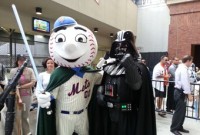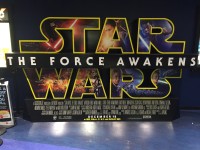
While I’m not planning on actually discussing major plot points here, there will be at least some allusions to what happened in the movie. If you haven’t seen it, please come back at another time. Yes, I know this blog isn’t about Star Wars, but it was an important event, and I felt compelled to write something. I’ll go back to the regularly scheduled programming later.
Before proceeding, I think it’s important to put my fandom in context. Obviously, I have seen all the movies more than once. Yes, even The Phantom Menace. I had some Star Wars toys as a kid. I vaguely remember being an Ewok for Halloween one year. I recall reading one or two books, but they didn’t leave any impression on me. I’m not an expert in the Expanded Universe, but I was generally aware of the Thrawn Trilogy and Luke Skywalker turning to the Dark Side. Also, I got pretty good at Star Wars Trivial Pursuit. That’s my perspective.
Now, this is your last chance to check out before any spoilers arise.
Personally, I loved the movie. Honestly, I think the movie went the direction it had to go even if the plot was a little too much the plot of A New Hope with some sprinkling in of Empire Strikes Back. For some this is a criticism. Did others, it’s a point of praise. Either way, I will say it was much better written than A New Hope.
In any event, the Rey-Luke parallels were obvious. Both from desert planets off the main grid. Both abandoned there (at least Luke had guardians). Both accidentally come across a droid with important information. Both didn’t know they were powerful with the Force. I thought the movie did a good job of not beating you over the head with it, but if you have seen the movies the parallels were obvious.
Speaking of obvious, I love that they didn’t try to change who Han Solo and Princess Leia were. Did we really expect that 30 years later they would’ve settled down in a little cottage on Naboo? Did we expect they would’ve had anything but a rocky relationship? Of course not. In essence, this is what The Force Awakens gets right. They know the characters, and they didn’t change them to try to make them something they weren’t.
Without giving anything away, Harrison Ford seemed as overjoyed playing Han Solo again as much as Han Solo seemed overjoyed to finally be in the mix of things again. Part of the reason might be because he got what he wanted. The good thing there was what happened was organic to the story, and it actually drove the plot of the movie and perhaps the new trilogy along.
That’s the thing. The Force Awakens really respects the characters and what happened in the original trilogy. It didn’t try to make anything they weren’t, nor did it try to shock you for shock’s value. The one thing less talked about was how the characters were reflective of the fans.
The older fans were Han Solo. We had our moment in the sun with the original trilogy. In reality, we were hoping for more while never really expecting to get it. We’re overjoyed being in a comfortable place like the Millenium Falcon. We’re excited to see our old friends and make new ones. Like Han, we’re answering a million questions about the Jedi and Luke Skywalker. We may seem perturbed, but deep down we love it. We want tons back in the mix while handing it off to the next generation.
Rey is the new Star Wars fans. They’ve heard of the Jedi. They’ve heard of Luke Skywalker and Han Solo. They have seen the movies, but they didn’t experience them the way their parents and grandparents did. When Rey is all wide-eyed in amazement that she’s actually talking to Han Solo about Luke Skywalker, I thought of my son getting his own trilogy to experience and to cherish.
That’s the best part of the movie. It transitioned. Yes, Luke is bound to have a massive role in Episode VIII, but the focus of the movies have now shifted. The original trilogy and the prequels made it readily apparent Star Wars was about Anakin Skywalker/Darth Vader. Many of us were more interested in Han, Luke, and Leia.
I can comfortably say Episode VII changed the focus from the aforementioned group to Rey, Finn, Poe, and Kylo Ren. I will be disappointed if Kylo Ren’s character arc mirrors Darth Vader’s. I’ll be disappointed if Rey’s is a carbon copy to Luke’s. Keep in mind, there’s some danger there with Rey apparently on a remote planet looking to train to become a Jedi, and the First Order’s Starkiller now destroyed.
There’s room for separation here. Kylo Ren is still training whereas Vader was already an accomplished Sith Lord. For her part, Rey has a more full fledged back story that Luke didn’t have. Luke thought he was with his aunt and uncle because Darth Vader killed his father. All Rey knows is she was abandoned, and she doesn’t know why. I’m going to be really aggravated if we find out that Rey and Ben were twins. I say this having already accepted we’ll see a “Rey, I am your father” scene. Yes, I know that’s not the quote.
Overall, The Force Awakens was a success. It respected the characters and the history. It was a terrific movie. It transitioned from the new to the old. It made you excited not only to see it again and again, but it also made you excited to see the next one. The bar was set very high for this movie, and at a minimum, the movie cleared that bar. I think it went much further than that. I think it created a new story that could conceivably go anywhere it wants. It’s not, nor should it feel tied down to, the arc of the original trilogy.
May the Force be with you.
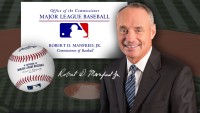
Commissioner Rob Manfred recently spoke out against player opt out clauses. The issue, if you want to call it an issue, came about, in part, due to the Jason Heyward and David Price signings. Here’s the Commisioner’s take:
The logic of opt-out clauses escapes me. You make an eight year agreement with a player. He plays well, and he opts out after three. You either pay the player again or you lose him. Conversely, if the player performs poorly, he doesn’t opt out and gets the benefit of the eight year agreement. That doesn’t strike me as a very good deal. Personally, I don’t see the logic of it. But clubs do what they do.
Keep in mind, the Commissioner could’ve said the same thing about teams carrying player options, but he didn’t say that. No, he essentially said these opt out agreements are bad for teams. I couldn’t disagree more.
First, let’s keep in mind who is getting opt out clauses in their contracts. In this offseason, it was a former Cy Young Award winner in Price and a young three time Gold Glove winner in Hayward. They were the two top free agents. Accordingly, they had the leverage to get the clauses inserted in their contracts. Without those clauses, it’s reasonable to assume those players go elsewhere.
With that in mind, let’s also keep in mind the opt out clause is a way to get a player you might not have otherwise obtained. The Marlins have one to Giancarlo Stanton as an attempt to keep a budding superstar around longer than they usually could. The Yankees used the provision to lure CC Sabathia to the Bronx. It was reported Sabathia didn’t want to come to New York, but rather, he wanted to return home to California. The opt out clause allowed the Yankees to offer an out in case Sabathia hated New York. Without the clause, it’s very possible the Yankees didn’t get him.
Speaking of Sabathia, the opt out clause protects the team from having to pay a player on the downside of his career. Sabathia had an opt out after his third year. To that point, the Yankess paid Sabathia $48.5 million over the course of three years. Sabathia was good for them goimg 50-23 a 3.17 ERA. In two of the three years, he was an All Star. The Yankees won the World Series. In all three years, he was top four in the Cy Young voting. He was also turning 32.
Sabathia never really officially opted out. Instead, he renegotiated his deal. The five year contact became an eight year contract. In the first four years, Sabathia has earned $92 million. For that $92 million, he has been 38-33 with a 4.35 ERA. He’s had one All Star appearance and no Cy Young votes. It’s been a disaster, especially when you consider the extenuating circumstances.
If the Yankees walked away when they should’ve, Sabathia gets a huge deal elsewhere. Sabathia’s down years happen elsewhere while the Yankees have free up cash to get whatever else they needed. Instead, they signed Sabathia to another deal, and Sabathia is taking up a roster spot for more money than he’s now worth.
Overall, if you want a top player, you don’t want to pay him during his decline, and you can show restraint not to re-sign an older player, the opt out clause is the way to go. Therein is the logic in the deal.
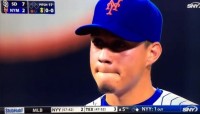
Going into the 2015 season, the Mets told everyone they were comfortable with Wilmer Flores as their shortstop. Going into this offseason, the Mets reminded everyone they made the World Series with Flores as their shortstop. As it turns out the Mets don’t regard Flores as anything more than a bench player.
With Daniel Murphy being a free agent, the Mets had the option to do the following with Flores: (1) leave him at shortstop or (2) move him to secondbase. The secondbase option became more viable when Ben Zobrist became a Cub. Instead the Mets traded for Neil Walker. After that, they signed Asdrubal Cabrera. In about a 34 hour timespan Flores went from starting middle infielder to a bench player.
Simply put, the Mets gave up on him. They gave up on a 25 year old baseball player they seemed to really like. They gave up on the idea that a hard worker like Flores would improve. Make no mistake, this has more to do with Flores’ bat than it has to do with his glove. It’s surprising because it was Flores’ bat that earned him the opportunity to play in the big leagues.
Simply put, while Flores showed some power, he was not very good at the plate. Last year, he hit .263/.295/.408. Walker hit .269/.328/.427. Cabrera hit .265/.315/.430. As an aside, Murphy hit .281/.322./.449. Seems important to mention since the Mets were making offensive and not defensive upgrades.
Last year, Flores had a UZR of 2.0 at secondbase and -2.5 at shortstop. Walker is coming off consecutive -6.8 UZR seasons at second. Here are Cabrera‘s UZRs at short since 2009: -5.0, -5.5, -11.0, -7.7, -12.8, -6.6, -6.0. Look at those numbers again. I know it’s hard for Mets fans to accept, but Flores is a better defender than Walker and Cabrera.
The reason it’s so hard is the early season troubles Flores had. He had trouble turning the double play. He had trouble making a play off his backhand. Here’s the thing. Remember the NLCS and World Series? Did either of those issues arise once? No. He was very solid at short, even if it was a limited sample size.
Ultimately, the Mets made these moves because of Flores’ offense, not his defense. They made these moves because they lost faith that Flores could ever improve enough to be an everyday player. Yes, they gave up on him being an everyday player. When you move a 25 year old to the bench, you’ve given up on him. You’ve given up on him when you bring in two weaker defenders in their 30s.
The Mets made these moves to improve their offense. It’s up for debate m as to whether it was the right move. What is not up for debate is the Mets giving up on Flores. It’s pretty clear that they did.
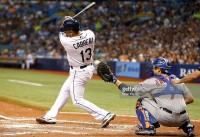
If you’ve read Andy Martino’s Winter Meetings article, there’s a lot to digest. There’s many ways to go, but first I wanted to address the Asdrubal Cabrera situation.
As you well know, the Mets acquired Cabrera. Depending on your point-of-view, Cabrera may or may not be an upgrade at shortstop. He’s a weaker defender. You’re relying on a good second half being a sign that he’s ready to overcome his struggles of the past five seasons. For all that, the Mets signed him to a two year $18.5 million contract. It’s a contract that might’ve depended on what Ben Zobrist did.
Supposedly, the Mets were willing to sign Zobrist to a four year $60 million contract. That would’ve been an average annual value of $15 million per year. This is what the Mets conveyed to Zobrist’s agent, Alan Nero, who coincidentally represents Cabrera. The Mets talked about both players with the agent. However, pay careful attention to this quote:
Before Zobrist made his decision, [Assistant GM John] Ricco felt he had to approach the pursuit of Cabrera delicately. The Mets needed to appear interested, but not so much that Nero thought they were turning away from Zobrist. Now, with that barrier lifted, Ricco and his group go hard after Cabrera, offering a two year, $18.5 million deal, and landing him that night. The process is simple: Will you take our money? Yes? Great, we have a deal.
I’m sure there are a number of ways to reasonably interpret that statement. Personally, I interpret it as the Mets didn’t have $24+ million in their budget, at least not for the middle infield. From the beginning of their conversations, Cabrera was a fallback option.
As Mets fans, we were informed if attendance increased than payroll would increase. Well, attendance increased. As a result, the Mets revenue increased somewhere between $45 – 60 million. Now, before the Mets made any moves, their projected payroll was going to be around $92 million. Adding $24 million to the middle infield would’ve increased the payroll to $116 million.
Keep in mind with that $116 million payroll, the Mets infield and rotation would’ve been locked down. You could’ve justified not pursuing a Yoenis Cespedes because you would’ve shown to everyone, let alone your fan base, that:
- The Mets were willing to outbid everyone to get the most coveted free agent on the market;
- You were willing to spend to address what you saw as a position of need; and
- You would’ve actually increased the payroll.
After having minimum $45 million in extra revenue, Cabrera should not have been contingent on Zobrist. The Mets should’ve been able to bring in both players. Either they are still facing budget constraints from the Madoff scandal, or the team doesn’t feel compelled to have a league average payroll despite whatever promises were made.
In any event, the Mets fans have been lied to by this team. It’s not alright. Attendance and revenues significantly increased. There will be a modest increase in payroll. This should make you question everything they do this offseason. Was Neil Walker really an improvement over Daniel Murphy, or is the team just selling that to us? Did the Mets trade Jon Niese because it was a reasonable deal, or was it because they needed to shed some payroll to have enough room for Walker and Cabrera?
I just look forward to the next free agent move, if there will be one. I’m curious how they’ll sell it to the fans. I wonder how much there’s left in the budget. These questions are more than reasonable and fair after reading this article.

Look, there are reasons why a team wouldn’t want either Daniel Murphy or Yoenis Cespedes. However, I can’t believe the #3 and #4 hitters for an NL Pennant winner have no market right now.
At different points this year both of the players showed their value. They showed how they can carry a team for almost one month at a time. Cespedes carried the Mets in August. Murphy carried the Mets in October. They were clutch. They were essential members of their teams. They both seem to have no suitors on the free agent market.
As for Murphy, the Mets went out to the trade market to get Neil Walker rather than sign Murphy to a deal. The Nationals have seemingly done the same by seeking to acquire Brandon Phillips. The Nationals are going this route despite needing a quality left handed bat. As for other teams, it’s pure conjecture on who would be interested.
That’s the same situation for Cespedes. The only thing we know about his market is his last two teams are out on him. The Mets aren’t interested in re-signing the CF who helped them go to the playoffs. The Tigers apparently don’t want their Gold Glove LF to return.
We know markets for these players should eventually develop, but I’m surprised it’s taking this long. If I were the Mets I would seek to move in quickly with shorter term deals to try to acquire these players. While I wouldn’t be thrilled with Cespedes in CF, I wouldn’t object to him signing a short term deal or a deal with an early opt out. As for Murphy, I still like the idea of bringing him back. I like the idea especially because of David Wright‘s back.
We’ll see what happens next. I know I’m even more intrigued because I didn’t see either player going unsigned for this long.
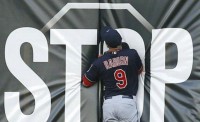
In looking to fill out their bench, the Mets have shown some interest in Ryan Raburn. As a right handed bat, you could do worse.
Last year was the best year of Raburn’s career. He set career highs in batting average, on base percentage, and slugging. It’s odd, but it’s not unusual for a player to have a career year at 34. It’s definitely strange that someone coming off a .301/.393/.543 season didn’t have his $3 million option picked up. It’s strange even if the team was a mid-market team like the Indians. It really makes you question what is happening there.
What’s happening was Raburn was limited to just 82 games. No, he wasn’t injured. It’s just that the Indians really limited him to playing against lefties. He had 176 plate appearances against lefties and only 25 against righties. It was a decision that makes sense. In his career, Raburn has hit .250/.297/.326 against righties and .264/.339/.487.
Looking at Raburn, two other players immediately come to mind. The first was Scott Hairston, who had some success in a similar role with the Mets. Where Hairston got into trouble was when a Mets team lacking depth had to play him more frequently than they would’ve liked. The other player was John Mayberry, Jr., who hit .164/.227/.318 in 59 games with the Mets. He was released in July.
Why was Hairston successful where Mayberry wasn’t? Who knows? They’re bench players. Bench players typically can’t be relied upon for yearly consistency. The main reason is you’re always relying on a small sample size.
Looking at his career numbers, we see Raburn hits lefties well, but nowhere near as well as he hit them last year. We see a player who is a poor pinch hitter with a triple slash line of .184/.309/.368 in 136 plate appearances (small sample size). We also see a player who is predominantly a corner OF. Here’s his games played by position over his 10 year career:
- 1B – 9 games
- 2B – 143 games
- 3B – 27 games
- LF – 261 games
- CF – 28 games
- RF – 171 games
- DH – 93 games
Last year, he only played left, right, and DH. He was predominantly a DH. It’s surprising because he’s been an average fielder. You know what he isn’t? A first baseman. You’re not a first baseman if you play 9 games there in 10 years. It doesn’t mean he can’t play there. It means we don’t know. If you remember with Mike a Piazza playing first is easier said than done.
Raburn would be an improvement over a player like Eric Campbell with his hitting against lefties. Campbell has hit .220/.318/.339 in 149 plate appearances. It should be noted, even if for argument’s sake, Campbell is a slightly better defender, a better bet at first base, and a much better pinch hitter. Campbell is a career .293/.426/.390 pinch hitter in 54 plate appearances.
So who would I rather have? Raburn. He’s the better player. However, if signing Raburn stands in the way of the Mets making a significant addition, then I’m alright with the Mets proceeding with Campbell on the bench. Overall, while Raburn is an improvement, he’s not so much of an improvement that he’s worth losing out on another player.
I’m not so much interested in Raburn as much as I’m interested as in what a Raburn signing would mean for the Mets.
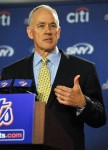
The prevailing thought is the Mets have been active this offseason making shrewd moves. Speaking of moves, are you able to name the first major league players acquired by the Mets under the Sandy Alderson regime? Good luck!
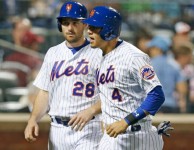
While reading up on my nightmare scenario of Daniel Murphy signing with the Nationals, I noticed something interesting. Look at this blurb from MLB Trade Rumors:
At the time of this writing [December 16, 2015], it’s not exactly clear who the leading teams are for the infielder, who turns 31 in April. The incumbent Mets apparently haven’t ruled out a reunion with Murphy, though they would like to sign him to a one- or two-year deal.
(Emphasis added, internal links omitted)
It’s a fascinating scenario. By reintroducing Murphy to the mix, you’re creating even more infield depth and even more versatility. With Neil Walker‘s platoon splits, Murphy can effectively platoon there. When David Wright needs to rest his back, Murphy can play there. Murphy can also play some first base allowing Lucas Duda to sit occasionally against the really nasty lefties.
Sure, you could argue he’s usurping Wilmer Flores‘ role. However, Murphy is a much better player. You’d rather have Murphy playing over Flores. Furthermore, that frees up Flores to focus on SS and possibly work on learning the OF to give Curtis Granderson and Michael Conforto the occasional day off, especially against lefties.
The move makes sense except for the following reasons:
- You’re asking Murphy to accept a reduced role and contract;
- You’re expecting Walker to accept a reduced role in a contract year; and
- You’re expecting Flores to be an effective MI and corner OF.
Unfortunately, it seems like the rumor was outdated. It was before the Mets obtained Walker. It seems unlikely Murphy will return to the Mets. I got excited for a minute until I realized it wasn’t realistic. Upon further review, it wasn’t.
However, it would’ve been interesting.
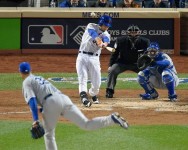
There are many out there calling the Mets offseason a success so far. Personally, I don’t see it. Yes, I know the offseason isn’t over, but we’re also pretty sure the Mets aren’t replacing Yoenis Cespedes‘ bat.
Overall, the Mets as constituted now are not better than the team that lost the World Series. Here was the lineup for the team that just lost the World Series, with their respective WAR from the 2015 season:
- Curtis Granderson 5.1
- David Wright 0.5
- Daniel Murphy 1.4
- Yoenis Cespedes 6.3
- Lucas Duda 3.0
- Travis d’Arnaud 1.7
- Michael Conforto 2.1
- Wilmer Flores 0.8
Combined 20.9
If the Mets make no other additions this offseason, which still remains a possibility, here’s the Mets 2016 starting lineup with the player’s WAR from last year.
- Curtis Granderson 5.1
- Neil Walker 2.4
- David Wright 0.5
- Lucas Duda 3.0
- Asdrubal Cabrera 1.7
- Michael Conforto 2.1
- Travis d’Arnaud 1.7
- Juan Lagares 0.6
Combined 17.1
On paper, barring any further additions the 2016 starting lineup is worse than the 2015 World Series team. This is despite how more “athletic” the Mets are in the middle infield. In response, the argument is the Mets are now deeper. Are they? Let’s compare the 2015 and 2016 benches.
Before comparing, it should be noted I’m going to use a traditional 13 position players and 12 pitchers split. That means I will have to eliminate once bench player from the 2015 Mets. I’m choosing to remove Kirk Nieuwenhuis from the roster as he was called up in September.
I’m also dropping Juan Uribe from the 2015 roster. When building a team, you’re going to want a backup shortstop. Uribe doesn’t fit the bill. Since Ruben Tejada was injured, and thus unavailable, I’m replacing him with Matt Reynolds, whom I’m assigning a 0.0 WAR since he didn’t play at all last year.
Here’s the modified 2015 World Series bench:
- Kevin Plawecki 0.9
- Matt Reynolds 0.0
- Michael Cuddyer 0.5
- Kelly Johnson 0.3
- Juan Lagares 0.6
Combined 2.3
Here’s the current bench, which would be subject to change with a free agent signing:
- Kevin Plawecki 0.9
- Wilmer Flores 0.8
- Ruben Tejada -0.1
- Kirk Nieuwenhuis 0.7
- Eric Campbell -0.5
Combined 1.8
Now to be fair, the 2016 bench will mostly likely not have Eric Campbell on the Opening Day roster. Eliminating his -0.5 would balance out these benches.
Here’s one big problem, if not Campbell then who? Let’s assume Mets fans get their way, and the team signs Denard Span. Span had a 0.7 WAR last year. Yes, that’s the same as Kirk’s. Slotting Span into the everyday lineup has this effect:
- Starting Lineup WAR increased from 17.1 to 17.2
- Bench WAR decreased from 1.8 to 1.7
- Eric Campbell or Kirk Nieuwenhuis is still on the Opening Day roster
Now, first counter-argument will be the offseason isn’t over, so the Mets can still make additional moves. Currently, without any other moves, the Mets payroll stands around $105.7 million. Let’s assume for arguments sake, the Mets have around $10 million to spend. With that $10 million, the Mets are looking to add a reliever, a CF, and another bat.
Span is estimated to receive about $12 million a year. Well, that blows the whole budget. Even assuming the Mets could get Span for less, they’re not going to have enough money for a reliever and another bat after that. So again, chances are either Campbell or Kirk will be in the Opening Day roster.
The next counter-argument is last year’s WAR doesn’t account for full years from Wright, d’Arnaud, or Conforto. This point-of-view is acceptable. However, you also have to acknowledge Granderson may be due for a regression at 35 years of age with a repaired torn ligament in this thumb. Also, based upon their histories, you can’t rely on Wright or d’Arnaud to last a full season. Essentially, while you can expect some players to improve or play more often, you can expect others to regress and/or suffer injuries.
Overall, the Mets still might be able to win the NL East and return to the playoffs in 2016. They will do so because of their pitching. However, objectively speaking, you have to admit the 2016 Mets are and will be weaker than the 2015 Mets team that lost the World Series.
That is unacceptable.

